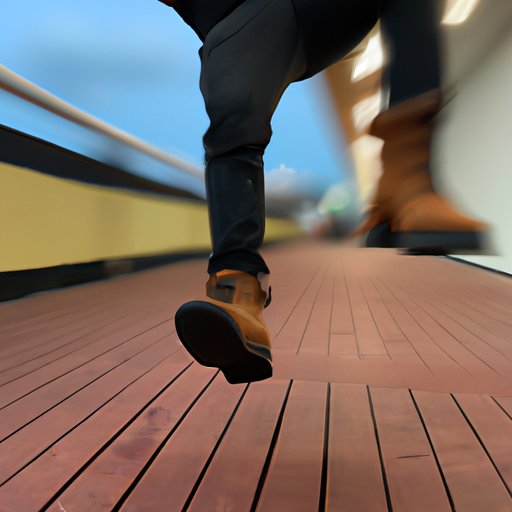Introduction
Tripping and falling can be an embarrassing and potentially dangerous experience. In addition to causing physical injuries, it can lead to emotional distress and social discomfort. While some people may only trip occasionally, others may find themselves frequently stumbling over their own feet. This article examines why people keep tripping and falling and offers possible solutions.

Identifying the Causes of Frequent Tripping and Falling
There are many different factors that could be contributing to a person’s tendency to trip and fall. Examining physical, mental health and environmental causes can help identify the root of the problem and develop an appropriate course of action.
Analyzing Physical Factors
Physical factors such as muscle weakness, poor posture, or imbalance can contribute to frequent tripping. A study published in the journal Gait & Posture found that people with weakened lower-limb muscles were more likely to experience falls than those with healthy muscle strength.1 Poor posture can also affect balance and increase the risk of tripping. Maintaining proper posture helps ensure the body is properly aligned and balanced when walking.
Imbalance is another common cause of tripping. An imbalance between the right and left sides of the body makes it difficult to maintain stability while walking. People who have suffered a stroke or other neurological injury may experience this type of imbalance, which can make them more prone to tripping and falling.
Examining Mental Health Issues
Mental health issues such as anxiety, stress, and depression can also lead to frequent tripping and falling. Anxiety can cause a person to become distracted and lose focus on where they are walking. Stress can cause a person to become tense and uncoordinated, making it harder to stay upright. Depression can also lead to feelings of lethargy and fatigue, which can cause a person to be less aware of their surroundings.
Exploring Environmental Causes of Tripping
The environment a person is walking in can also play a role in tripping and falling. Uneven surfaces, such as potholes or cracks in the sidewalk, can be difficult to navigate and can easily cause a person to stumble. Clutter can also increase the risk of tripping, as it can obscure a person’s view of the ground. Poor lighting can also make it difficult to see obstacles in one’s path, increasing the risk of tripping.
Investigating the Role of Balance
Balance plays an important role in preventing tripping and falling. Balance exercises can help improve coordination and stability, reducing the risk of tripping. Exercises such as single-leg stands and toe taps can help strengthen the lower-body muscles and improve overall balance.2 Tai chi is another great way to improve balance, as it combines slow, gentle movements with deep breathing and meditation.

Understanding the Impact of Vision Problems
Vision problems can also contribute to tripping and falling. Common vision issues such as nearsightedness and farsightedness can make it difficult to see obstacles in one’s path. Cataracts, glaucoma, and macular degeneration can also impair vision and increase the risk of tripping.
If vision problems are suspected, it is important to visit an eye doctor for an evaluation. Treatments such as eyeglasses, contact lenses, and surgery can help improve vision and reduce the risk of tripping.

Evaluating the Effects of Footwear
The type of shoes a person wears can also affect their risk of tripping and falling. Shoes should fit properly and provide adequate support and cushioning. High heels, flip flops, and other types of unstable shoes should be avoided, as they can increase the risk of tripping.
Additionally, shoes should be checked regularly for wear and tear. Worn-out soles or loose laces can make it difficult to walk safely and increase the risk of tripping.
Conclusion
Frequent tripping and falling can be caused by a variety of factors, including physical, mental health and environmental issues, balance, vision problems, and footwear. To reduce the risk of tripping, it is important to address any underlying medical conditions, practice balance exercises, and choose appropriate footwear.
By understanding the potential causes of frequent tripping and falling, it is possible to take steps to reduce the risk of tripping incidents. With the right approach, it is possible to regain confidence in your footing and move forward without worry.
(Note: Is this article not meeting your expectations? Do you have knowledge or insights to share? Unlock new opportunities and expand your reach by joining our authors team. Click Registration to join us and share your expertise with our readers.)
